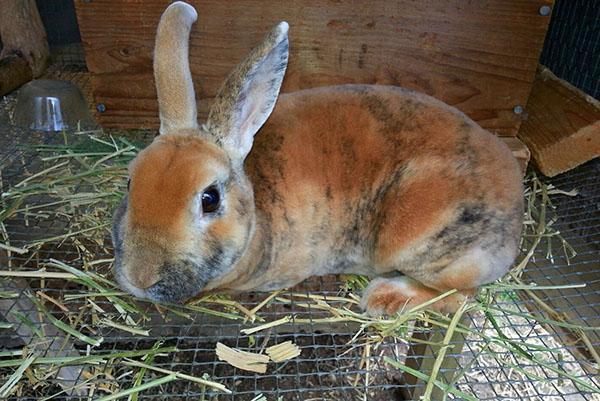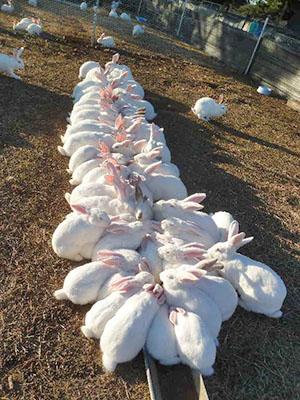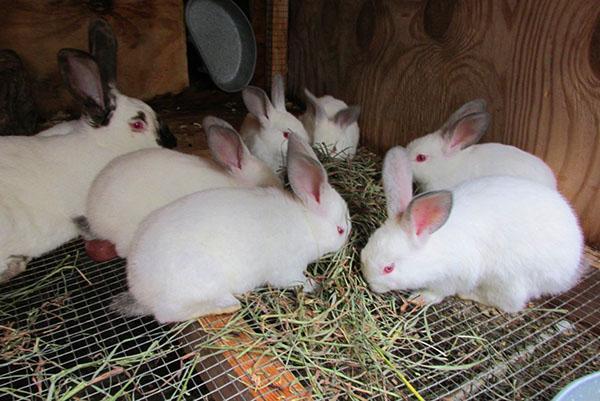Breeding rabbits at home on a personal plot
 Increasingly, in the backyards of private households and even summer cottages, you can see domestic animals. Breeding rabbits attracts by the simplicity of this species, the rapid growth of animals, their active reproduction and a quick return on investment.
Increasingly, in the backyards of private households and even summer cottages, you can see domestic animals. Breeding rabbits attracts by the simplicity of this species, the rapid growth of animals, their active reproduction and a quick return on investment.
The costs of keeping rabbits are low, and in exchange for care and attention, the animals will provide the owners with 4–5 kg of meat per carcass, fur skins and down.
What are the features of breeding, raising and feeding rabbits in a private backyard?
Read also the article: how to feed rabbits at home for beginners?
How to keep rabbits?

This method has a number of undeniable advantages. First of all, cellular content helps:
- monitor the condition, nutritional status and health of each animal separately;
- feed the rabbits as needed and on time, if necessary, adjust the diet;
- mating animals at the best time;
- select rabbits for breeding on the basis of long careful observation;
- get strong young growth;
- to conduct an effective fight against diseases and parasites, to establish prevention.
Thanks to such opportunities, which make life easier for experienced breeders and beginners, keeping rabbits in cages has become widespread throughout the world. How to make DIY rabbit cages - detailed article!
Comfortable rabbit cage
 One of the significant advantages of using the cage content is the long, almost year-round stay of the livestock in the air, which:
One of the significant advantages of using the cage content is the long, almost year-round stay of the livestock in the air, which:
- has a good effect on the body's defenses;
- gradually improves the quality of fur and fatness of animals;
- has a positive effect on productive qualities;
- prevents the reproduction of pathogenic microflora and the spread of diseases.
If you have portable cages, livestock or single rabbits, for example in winter when the temperature approaches –25 ° C, or during mating and mating, you can move under a roof.
Having decided to start breeding rabbits at home, a novice rabbit breeder should take care of the arrangement of housing for the wards.
 To save space, stationary rabbitries are made in tiers, placing 2-3 cages one above the other. Adult livestock and young animals are kept separately, placed in their own or in group cages at the age of three months.
To save space, stationary rabbitries are made in tiers, placing 2-3 cages one above the other. Adult livestock and young animals are kept separately, placed in their own or in group cages at the age of three months.
Permanent and temporary structures must meet the safety and comfort requirements of eared guests.
The most important thing for domestic rabbits is keeping them clean, warm, and dry. This is taken into account when choosing the design of the rabbit houses and their future location on the site. For breeding and keeping rabbits in the open air, insulation is provided inside the houses. And to make it easier to maintain cleanliness, the floor in the cage is made mesh or slatted with small intervals for pouring droppings and debris.
Cleanliness and other conditions for successful rabbit breeding
 Living in cleanliness and comfort, rabbits are not susceptible to disease, quickly gain weight, build up good fur and readily breed. How to keep rabbits in a private backyard? What conditions will fully suit fluffy animals?
Living in cleanliness and comfort, rabbits are not susceptible to disease, quickly gain weight, build up good fur and readily breed. How to keep rabbits in a private backyard? What conditions will fully suit fluffy animals?
Unpretentious, hardy animals in the open air survive in thirty-degree frosts, and in summer they endure the same intolerable heat. However, the task of the breeder is not to test the animals, but to grow them. Both heat and severe frosts make their own adjustments to breeding, raising and feeding rabbits, therefore:
- in winter, the cages must be protected from frost and icy wind, which is destructive for animals; more straw is placed inside;
- in summer, portable cages are taken out in partial shade, and stationary structures are protected with awnings and awnings, they use moisture irrigation for animals from overheating.
 Branches, fresh cut grass and hay can be used as natural shelter. On the hottest days, the roofs of the cages are doused with water in order to quickly and effectively reduce the temperature inside and slightly raise the humidity.
Branches, fresh cut grass and hay can be used as natural shelter. On the hottest days, the roofs of the cages are doused with water in order to quickly and effectively reduce the temperature inside and slightly raise the humidity.
If the breeding of rabbits is carried out indoors, then the animals need a long daylight hours, ventilation, a comfortable temperature regime and air humidity within 60–70%.
Rules for caring for rabbits when breeding at home
 There are several rules, observing which experienced, and especially those beginning to breed rabbits at home, livestock breeders can achieve consistently high results:
There are several rules, observing which experienced, and especially those beginning to breed rabbits at home, livestock breeders can achieve consistently high results:
- Cleaning of cages, drinkers and feeders should be daily and very thorough.
- With an interval of 10 - 14 days, the cells are disinfected, as well as all equipment in them.
- Ventilation and maintaining an acceptable moisture content are as important as cleanliness and balanced feed.
- Rabbits when breeding in cages must be protected from drafts.
- Constant availability of clean water and fresh, age-appropriate feed.
- Animals are regularly examined, if a disease is suspected, a weak rabbit is quarantined.
Breeding rabbits at home is not complete without necessarily vaccinating the livestock, as well as without adding vitamin supplements to drink and feed, especially necessary for pregnant females, young animals and all individuals in the winter.
Hay and water in the rabbit cage must be present at all times. In addition to compound feed, animals are offered fresh grass, root crops, grain, apples. If succulent feed is mowed on its own, you should not choose areas near roads or industrial enterprises.
Caged feeders, hay nurseries and drinkers must be clean and stable so that the moving animals do not overturn them.
How to breed rabbits and get offspring from them?
 For a male to impregnate a female, she must be hunting. Regardless of the season, this state lasts up to five days with a break of 8-9 days. Already a day after the birth of a new generation of rabbits, the female is ready for a new fertilization.
For a male to impregnate a female, she must be hunting. Regardless of the season, this state lasts up to five days with a break of 8-9 days. Already a day after the birth of a new generation of rabbits, the female is ready for a new fertilization.
The signal that the female is ready to go to the male's cage can be considered restless behavior, loss of appetite, and the most sure sign is rush of blood and swelling of the genital loop.
Adult males are no less active. During the day, the rabbit covers up to four females, coming into the hunt literally in a few minutes after the previous mating. So that the producer does not weaken from exhaustion, the females are placed in the cage with a break of two days.
For breeding, rabbits are selected according to external indicators, age and breed characteristics. Sick, weak, too young animals are not allowed to mate.
 The rabbit awaiting the offspring is equipped with a nest in advance. When rabbits appear, they need special care and attention.
The rabbit awaiting the offspring is equipped with a nest in advance. When rabbits appear, they need special care and attention.
If the animal is not supposed to be allowed into breeding, rabbits at the age of 3-4 months are castrated, which leads to an early gain in weight and an improvement in the quality of meat. The slaughter of livestock is carried out starting from 4 months of age. But in order to get thick strong fur, it is better to wait until the animals molt. This happens six months or a little later, depending on from the breed of rabbits.
A video about breeding rabbits and all the nuances of their feeding, keeping and breeding will be useful for both beginners and already venerable rabbit breeders. Such information helps to replenish the baggage of knowledge and avoid annoying mistakes, sometimes leading to undesirable consequences for the entire economy.